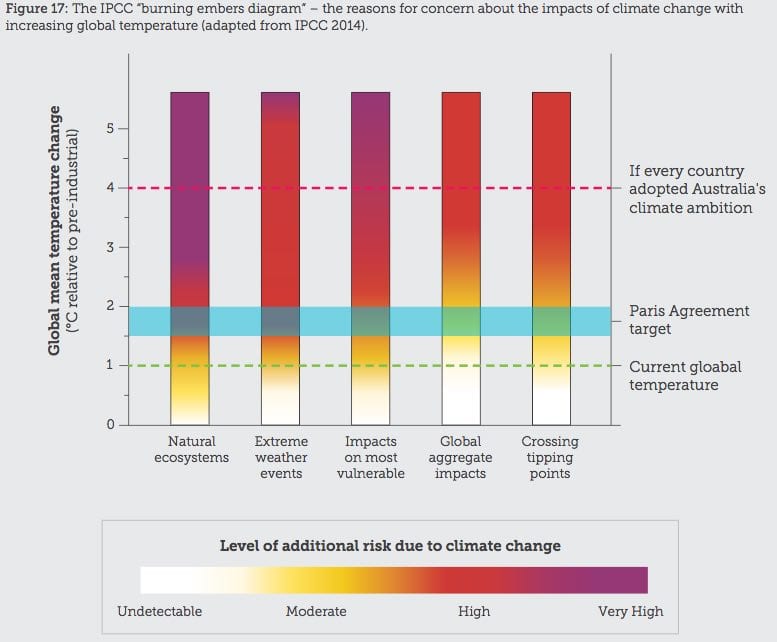As the 23rd UN Climate Conference in Bonn nears the end of its first week, a new report has highlighted just how far Australia is lagging behind the rest of the world in its efforts to avert catastrophic global warming – and how bad it would be if everyone else was putting in such a woeful effort.
The report, the latest edition of the Climate Council’s signature bi-annual Critical Decade series, describes Australia’s emissions reduction target of 26-28 per cent on a 2005 baseline as “unusually weak,” and nowhere near its fair share in tackling global warming – a situation that boils down to “a decade of interference by vested interests” and a shortage of political courage.
“Australia is failing to tackle climate change with emissions rising and a lack of any coherent, national approach to reduce emissions in the short, medium or long term,” the report says. “We are known as a global climate laggard.”
So how far behind is Australia lagging? Here are a couple of charts that help put it in perspective.
 This first, pictured above, shows a comparison of Australia’s commitments at the 2015 Paris climate conference to those of other OECD countries. As the Climate Council notes, this shows that Australia is far behind the level of climate action around the world, with a commitment “inconsistent with limiting temperature rise to no more than 2°C.”
This first, pictured above, shows a comparison of Australia’s commitments at the 2015 Paris climate conference to those of other OECD countries. As the Climate Council notes, this shows that Australia is far behind the level of climate action around the world, with a commitment “inconsistent with limiting temperature rise to no more than 2°C.”
“Compared to an average annual rate of emission reductions of 2.6% pledged by many developed countries, Australia’s proposed rate of emissions reduction is only 1.6% per annum,” the report says. “Worse yet, our emissions continue to rise!”
 The second graph, above, is adapted from the Intergovernmental Panel on Climate Change (IPCC) “Burning Embers” diagram on 2014, which is based on a synthesis of “thousands of peer-reviewed scientific papers to assess the degree of risk at increasing levels of global average temperature.”
The second graph, above, is adapted from the Intergovernmental Panel on Climate Change (IPCC) “Burning Embers” diagram on 2014, which is based on a synthesis of “thousands of peer-reviewed scientific papers to assess the degree of risk at increasing levels of global average temperature.”
What it shows, is that the Australian government’s approach, if adopted globally, would lock in a dramatic rise in global temperatures of around 4°C, “resulting in worsening extreme weather events and catastrophic damage to natural systems that support human life.”
As the report notes, there is a significant difference in the degree of risk between the 1.5°C and 2°C Paris targets, with higher risks of damage to natural ecosystems and more intense and/or frequent extreme weather events for the 2°C target.
“At a 2°C temperature rise, there is a high level of risk for 3 of the 5 categories – impacts on natural ecosystems, extreme weather events, and impacts on the most vulnerable. That is,
a 2.0°C temperature rise is not a “safe” level of climate change,” the report says.
“A 4°C temperature rise (business-as-usual) would lead to a vastly different world, with very high risks to many natural ecosystems and highly damaging impacts on the most vulnerable.”










